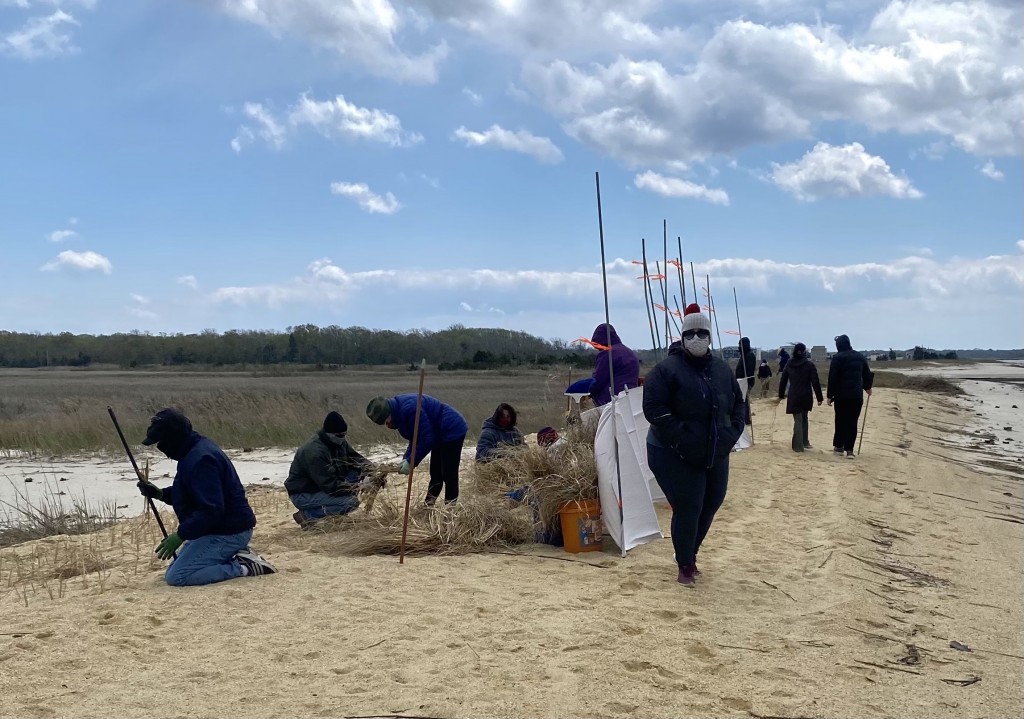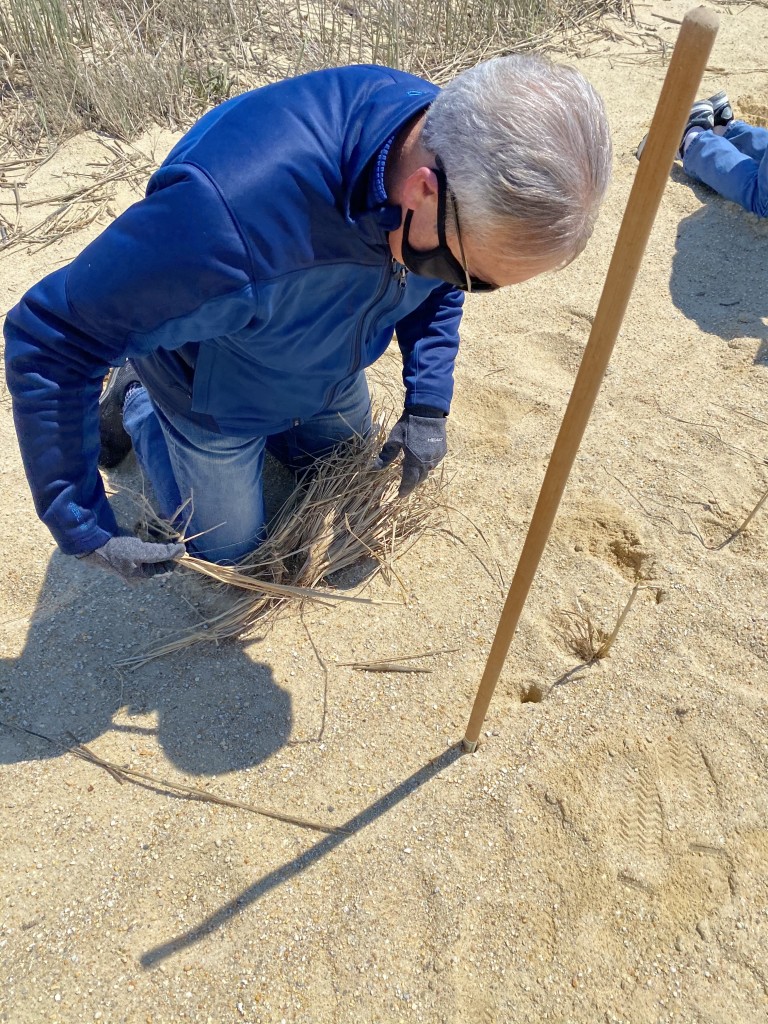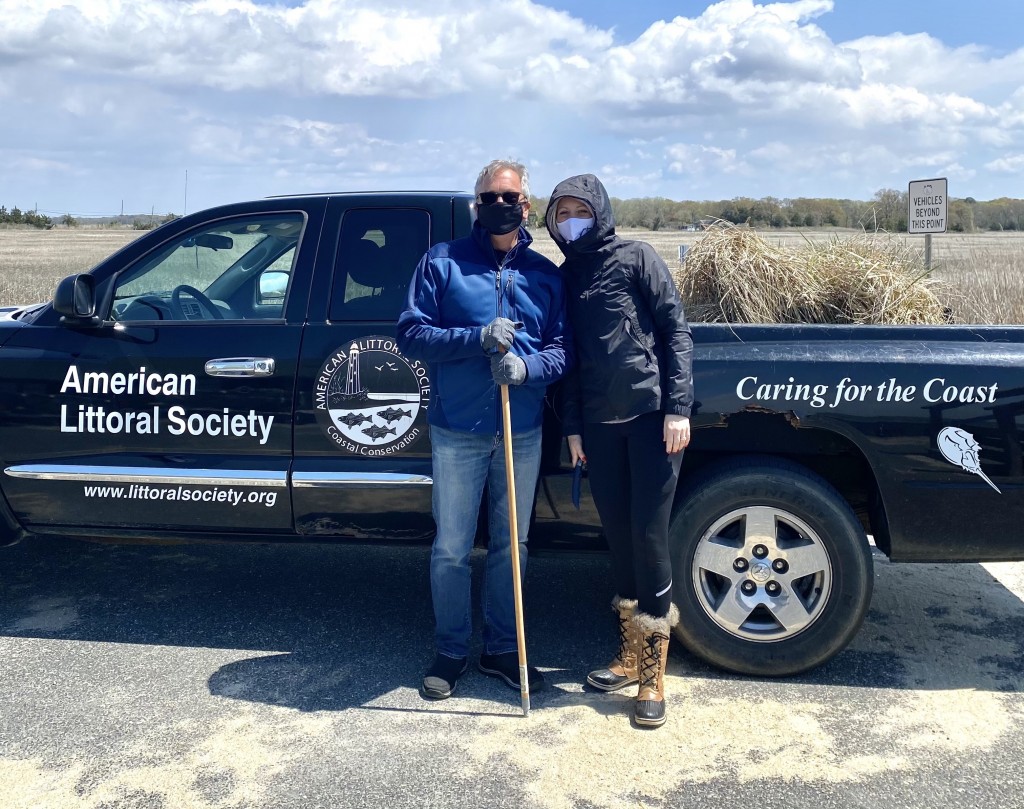Middle Township partners with conservationists to improve beaches
Earth Day projects part of ongoing work to protect horseshoe crab habitat



Top: Volunteers and staff from the American Littoral Society conduct an Earth Day dune grass planting and cleanup on South Reed’s Beach in Middle Township. The society works to preserve the ecology of Middle Township beaches. Middle: Middle Township Mayor Tim Donohue digs in to plant dune grass. Bottom: Middle Township Mayor Tim Donohue and Business Administrator Kim Krauss volunteer on Earth Day.
Cape May Court House, N.J. – Each spring, the American Littoral Society takes the lead on the intricate work of protecting Middle Township beaches for residents – and not just the human ones.
The environmentalists blend innovative strategies and manual labor in the fight to protect the beaches’ horseshoe crab habitats. Red knots, one of the furthest-migrating bird species in the world, rely on the precarious supply of the crab eggs. The shorebirds stop at Middle Township beaches each spring on their 9,000-mile trip from South America to their breeding grounds in the Arctic.
“A healthy ecosystem is the Delaware Bay’s foundation of economic well-being. People come to see the natural phenomenon from all over the world.” said Tim Dillingham, the executive director of the American Littoral Society. “Supporting habitats is in everyone’s best interest.”
The nonprofit conservation group plans a variety of cleanup projects and pursues grants to fund sand replenishment. Middle Township government also embraces the “tremendous responsibility” of caring for the area’s natural resources, Dillingham said.
Partners in preservation
On Earth Day, Middle Township Mayor Tim Donohue and Business Administrator Kim Krauss put their hands in the sand, joining the society in planting dune grass along South Reed’s Beach to protect the horseshoe crab habitat. The day also included a beach cleanup, with Township staff hauling away the trash.
“It’s important to protect our natural resources,” noted Larry Niles, a wildlife biologist who works with the Littoral Society and this month oversaw the addition of just under 5,000 tons of sand to repair breaches at Reed’s Beach, Pierce’s Point and Kimbles Beach.
Flooding causes the breaches in the sand, creating conditions where crabs can get stranded and die. Replenishing the sand and rebuilding dunes is essential to saving crab habitats.
“We want to thank Larry Niles and the team from the American Littoral Society, including Tim Dillingham, Quinn Whitesall and Shane Godshall, for their years of hard work to protect the fragile ecosystem on our Delaware Bay shoreline,” Donohue said. “Administrator Kim Krauss and I were honored to join a great group of volunteers for some Earth Day dune grass planting in support of this good work.”
The Township has provided logistical support to help the conservationists in their mission.
Township Committee passed an ordinance in April 2020 to prohibit driving on the shoreline and beaches along the Delaware Bay, including Cook’s Beach, Norbury’s Landing, Pierce’s Point, Reed’s Beach and Sunset Beach. There are select exceptions, such as for NJ Department of Environmental Protection staff and the Army Corps of Engineers.
Environmentalists had supported the measure to prevent beach damage and protect migrating birds.
The Township also has helped secure permission from local land owners for the Littoral Society to work on their bay shore property.
Edge of extinction
While federal and state support is critical to environmentalists, local municipalities can become closely involved with the cause, Dillingham explained.
“We see the communities as stewards of these animals that have been around for 450 million years and the birds that have been stopping here on this migration for thousands of years.”
But after 450 million years on earth, horseshoe crabs’ numbers have dwindled on Middle Township beaches. Overharvesting in the late 1990s dramatically reduced the crab population. Then, in 2012, Hurricane Sandy wiped out much of the crab spawning habitat. Niles said blustery storms over last winter had similar effects to Sandy.
Warming temperatures also have left the beach line more vulnerable, he said. “The bay isn’t freezing anymore, so there’s a lack of ice to shield the shoreline.”
The horseshoe crab numbers are still about half of what they once were, but conservationists say having the Township’s full support has helped them expand the habitats – and save the birds that feed on the crabs’ eggs.
“The partnership is key to the success that we’ve had to keep the red knots from going over the edge of extinction,” Dillingham said. “Middle Township has been such a leader in collaborating with everything we do. “
Tons of sand, endless dedication
The constant addition of sand requires a steady influx of funding. The Littoral Society joins forces with Niles’ Wildlife Restoration Partnerships and Stockton University’s Coastal Research Project to pursue grants in support of their work.
The conservationists received a $250,000 grant from the National Fish and Wildlife Foundation last year and this year is seeking cash from the state to match grants.
In the meantime, the work continues. The environmental advocates are now experimenting with breakwaters – barriers made of stone with oyster shells backing them – to tame waves and protect the beach.
“Our projects are trying to bring serious science to this. It’s adaptive management. We’re monitoring everything so that whatever we do will inform the next project,” Niles said.
The team is also committed to involving the community.
A breakwater project is planned for Pierce’s Point and the process will include a stakeholder meeting, Niles said.
The conservationists’ research to provide better habitats for crabs can get down to minute details, such as measuring eggs and checking the coarseness of sand. But there’s a payoff for those who love to see nature in action, Niles said.
“Because of the protection that we provide, people who want to see the migration can come to see the red knots.”

